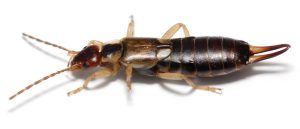The common pincer bug: Earwigs
 As menacing as they appear, earwigs are annoying garden nuisances that often find their way inside apartments and homes. Commonly known as pincer bugs due to their long set of pinching mandibles, these pests feed on other insects and all types of foliage (e.g. Dahlia, roses, sunflower, lettuce, etc.) and like cockroaches, they despise light.
As menacing as they appear, earwigs are annoying garden nuisances that often find their way inside apartments and homes. Commonly known as pincer bugs due to their long set of pinching mandibles, these pests feed on other insects and all types of foliage (e.g. Dahlia, roses, sunflower, lettuce, etc.) and like cockroaches, they despise light.
When outside during daytime hours, they can typically be found in dark, damp areas. If your home’s doors and windows are not properly sealed or if there are any cracks and crevices around leading to the interior, do not be surprised to find an earwig lying around.
The good news is they are not aggressive towards people, but can do a number on your garden if given the chance. Take proper measures to keep them away from the property, and here are a few, simple steps how.
Keeping earwigs at bay
You will obviously want to address any earwigs that are currently living indoors. The first areas to check are behind baseboards and gaps near sinks; the damp environment your home’s plumbing provides matches closely with what these bugs are use to in their natural habitat. Catching them by hand is one method, but the only way to guarantee every pest has been removed is to lure them out of their hiding spots.
Crumple up pieces of unused newspaper and place them near cupboards and other potential areas the earwigs may be located. The paper will act as a source of shelter and thus attract them. You can also lay down a small cup of vegetable oil; the scent will draw the bugs in and they will be permanently trapped.
If you want to skip straight to the extermination phase, pick up a bottle of either Diatomaceous Earth or Boric Acid powder. These substances are harmless to humans and pets, but serve to dissolve the protective exoskeleton, in effect killing them shortly after contact.
Deterring the pests outdoors can be done a few ways, though a comprehensive approach is always the best route to take. First off, buy a birdfeeder! Leave it to nature’s food chain to resolve your bug problem. A yard that is free from excess debris (e.g. leaves, sticks) and that is sprayed with pesticide will also do the trick.
